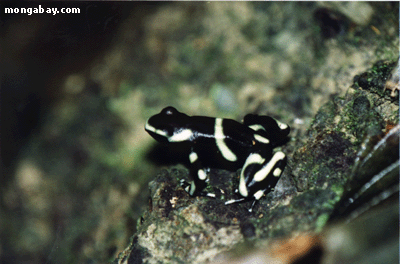What Eats Poison Arrow Frogs and Why are they Toxic?

|
Scientists are unsure how poison arrow frogs become so toxic, but it is due to something in their environment as frogs raised in captivity are not poisonous. Mark J. Plotkin explains in Medicine Quest:
-
Poison dart authority Dr. John Daly hypothesized that (1) the amphibians make the [toxic] alkaloids themselves; (2) they made the alkaloids from something that they consumed; or (3) they collected and store the compounds from a component of their diet ... [The answer] seems to be a combination of all three. Some of the compounds (or their precursors) are found in insects eaten by the frog: alkaloids are taken in and stored from beetles, ands, and millipedes. But it was not just a question of ingesting and sequestering any and all alkaloids: when ants containing two different alkaloids were fed to the frogs, the little amphibians stored only one alkaloid in their skin and apparently excreted the other. And, in some instances, the frogs were observed seeking out and consuming particular species of insects that harbored compounds that the frogs typically stored in their own skin.
More information:
Deriving a non-opiate painkiller [ABT-594] from Epipedobates tricolor [mongabay.com]
More poison arrow frog pictures [mongabay.com]
Most poisonous creature could be a mystery insect [USA Today]